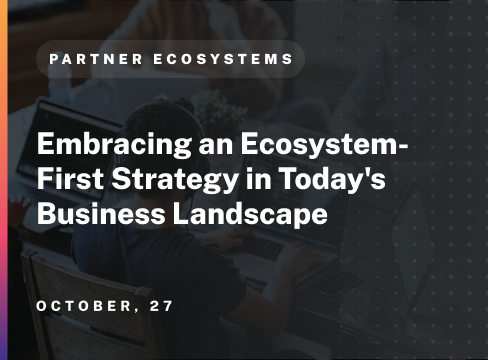The traditional methods of operation no longer suffice, and businesses are in dire need of strategies that can seamlessly integrate various elements for optimal performance. Enter the ecosystem-first strategy – a transformative approach that emphasizes interconnectedness and collaboration. But what does it truly entail, and why is it gaining traction?
In an expert panel discussion, we had the privilege of gaining insights from two industry leaders: Chris Samila, Co-Founder and Chief Partnership Officer at Partnership Leaders, and James Hodgkinson, SVP of Ecosystems at 360insights.
Their perspectives shed light on the nuances of this strategy and its pivotal role in the future of business operations.
The Rise of the Ecosystem-First Strategy
The business world is no stranger to change. Over the past decade, we’ve witnessed a seismic shift in how companies operate, driven largely by technological advancements and the proliferation of Software as a Service (SaaS) solutions.
This evolution has ushered in the need for a fresh approach- one that prioritizes collaboration, integration, and interconnectedness.
This is where the ecosystem-first strategy comes into play.
But why the sudden emphasis on ecosystems?
“The biggest reason ecosystems are becoming so top of mind for everybody is because the world has changed in the last ten years,” said Hodgkinson.
Traditional go-to-market strategies are being challenged by the sheer volume of tech companies emerging on the scene. With hundreds of thousands of technology providers vying for a piece of the market pie, businesses are realizing the importance of leveraging their ecosystems to navigate the complexities.
It’s not just about indirect sales or channel partnerships anymore. The ecosystem-first strategy is about recognizing the interconnected nature of today’s business environment and harnessing it.
Building a Robust Tech Stack
This part isn’t just about having the latest tools. It’s about having the right tools that can seamlessly integrate, analyze, and optimize the vast amounts of data flowing through the ecosystem.
Why is this so crucial?
With the myriad of interactions happening within an ecosystem, from customer touchpoints to partner collaborations, there’s a goldmine of data being generated.
Samila emphasized, “The tooling to really support all those different kinds of partner types is definitely a work in progress still.”
This underscores the importance of having a tech stack that can not only capture this data but also make sense of it.
Hodgkinson pointed out that there are key metrics that the ecosystem can significantly influence.
A well-integrated tech stack ensures that different parts of the business, from sales to marketing to product development, can work in harmony, driving unified goals and strategies.
Four Steps to Build a Robust Tech Stack
So, how do you build a tech stack for your partnership and company? Here are some steps to consider:

Step 1: Assess Current Tools
Begin by taking a comprehensive inventory of the tools and technologies you currently employ. Understand their functionalities, strengths, and limitations. This assessment will not only help you identify gaps in your current setup but also prevent unnecessary expenditures on redundant tools.
It’s essential to know where you stand before determining where you want to go.
Step 2: Define Clear Objectives
Every tool in your tech stack should serve a purpose. Before adding a new tool or replacing an old one, clearly define what you aim to achieve with it.
Are you looking to improve data analytics? Enhance customer interactions? Streamline internal communications?
By setting clear objectives, you ensure that every component of your tech stack aligns with your business goals and contributes to your overarching strategy.
Step 3: Prioritize Integration
In today’s interconnected business environment, isolated tools can hinder efficiency.
Prioritize tools that offer seamless integration capabilities with other systems in your stack. This not only ensures smooth data flow across platforms but also reduces the chances of data silos and fragmentation.
Integrated tools can communicate with each other, providing a holistic view of operations and enabling better decision-making.
Step 4: Invest in Training
The most advanced tech stack is rendered ineffective if your team doesn’t know how to use it. Once you’ve selected your tools, invest time and resources in training your staff.
Ensure they understand each tool’s
- Functionalities
- Best practices
- Potential pitfalls
A well-trained team can maximize the potential of your tech stack, leading to improved efficiency and productivity.
The Power of Executive Buy-In
The true catalyst for change often lies in the hands of those at the helm. Executive buy-in isn’t just about getting a nod of approval from the C-suite; it’s about fostering genuine understanding, enthusiasm, and commitment from top leadership.
“One of the biggest reasons ecosystems are becoming so top of mind for everybody is because the world has changed in the last ten years,” Hodgkinson said.
When executives are on board, the ripple effect throughout the organization is profound:
Alignment with Vision and Strategy
For any initiative to succeed, it must align with the company’s broader vision and strategy. When executives buy into an ecosystem-first approach, it sends a clear message that this strategy is not a fleeting trend but a core component of the company’s future direction.
Resource Allocation
With executive support, necessary resources – be it budget, manpower, or technology – become more accessible.
Hodgkinson emphasized the importance of this, noting the challenges of:
- Customer adoption: Without the buy-in from leadership, it can be hard to move people to a new platform or process.
- Utilization: The success of any initiative relies heavily on how well it’s implemented and adopted. Having a team focused on onboarding new users or developing training materials can help ensure stakeholders use the system properly.
- Churn risks: Projects often go awry if users don’t understand the value proposition of the system. Having an understanding of user needs helps to identify and address any potential problems early.
Addressing these challenges requires not just strategy but also the resources to execute it.
Driving Organizational Culture
Culture often trickles down from the top. When executives champion an ecosystem-first strategy, it fosters a culture of collaboration, innovation, and adaptability.
Teams are more likely to embrace change, collaborate across departments, and seek out partnerships that align with the ecosystem approach.
Mitigating Resistance
Change often meets resistance. But when the directive comes with the weight of executive support, potential roadblocks are minimized.
Employees understand the importance and urgency of the shift, reducing friction and accelerating implementation.
Building the Right Team for an Ecosystem-First Approach
An ecosystem team isn’t just another department within the organization; it’s the bridge that connects various functions, ensuring alignment and cohesion.
As Hodgkinson highlighted, an ecosystem team serves as an “enablement counterpart to all other functions within an organization.”
This team collaborates closely with product marketing, corporate marketing, and the product team, ensuring that the ecosystem strategy is woven into the fabric of the organization.
Key Characteristics of an Effective Ecosystem Team
At its core, an ecosystem is about people. Building the right team is paramount to ensuring the success of this approach. Here are the characteristic of an effective ecosystem team:
- Agility: The business landscape is dynamic, and the ecosystem team must be agile enough to adapt to changing circumstances, be it market trends, partner dynamics, or internal shifts.
- Collaborative Mindset: Given the interconnected nature of the ecosystem approach, the team must excel in collaboration, working seamlessly with various departments and external partners.
- Outcome-Oriented: Hodgkinson emphasized that ecosystem-related activities must be outcome-based. The team should focus on measurable results, ensuring that the strategy aligns with business objectives and delivers tangible value.
- Strategic Vision: While day-to-day operations are crucial, the team must also have a strategic vision, understanding the broader implications of the ecosystem-first approach and planning for the long term.
Nurturing and Scaling the Team
Building the right team is just the beginning. Continuous training, feedback, and growth opportunities ensure that the team remains at the forefront of the ecosystem-first approach.
As the strategy evolves, the team should scale, bringing in diverse skills and perspectives to enrich the ecosystem dynamics.
“The true payoff is going to come in the two to three year horizon,” Hodgkinson said
This sentiment underscores the importance of not just building but also nurturing and scaling the right team for the journey ahead.
Crafting a Strong Partnership Framework
Crafting a robust and organized partnership framework is the linchpin that ensures these collaborations are fruitful, sustainable, and aligned with business objectives.
Hodgkinson emphasized the significance of understanding one’s ecosystem architecture and recognizing where a business fits within that vast network. This clarity is foundational to crafting a partnership framework that resonates with the business’s goals and market positioning.
Here are five ways you can do it:
1. Alignment with Business Metrics
Hodgkinson emphasized the importance of aligning with metrics that already exist within the business. Instead of creating new objectives, the partnership framework should seamlessly integrate with the company’s existing goals and KPIs.
This ensures that partnerships directly contribute to the business’s overarching objectives and can be measured effectively.
2. Strategic Partner Identification
Not all partnerships are of equal value. It’s crucial to prioritize and identify key players that resonate with the company’s strategic vision and can drive significant value.
By focusing on these strategic collaborations, businesses can ensure that they’re leveraging partnerships that align with their market positioning and long-term goals.
3. Clear Expectations
From the outset, it’s vital to establish clarity.
To start, clearly define each partner’s:
- Roles
- Responsibilities
- Expectations
This level of transparency ensures that all parties are on the same page, reducing potential conflicts and misunderstandings. It sets the stage for a partnership built on trust and mutual benefit.
4. Continuous Evaluation
The business landscape is ever-evolving, and so should partnerships. Regular evaluations ensure that collaborations remain relevant, beneficial, and in tune with current market dynamics.
This iterative approach allows for timely adjustments, refinements, and, if necessary, exits, ensuring that the partnership remains agile and responsive
5. Education and Communication
Keeping the broader organization informed is paramount. Hodgkinson stressed the importance of consistently updating and educating the business on partnership developments.
Regular communication fosters trust, ensures alignment, and provides a clear picture of the partnership’s progress and value to stakeholders at all levels.
Challenges and the Road Ahead
The journey towards an ecosystem-first approach, while promising, is not without its hurdles.
As businesses navigate this transformative path, they encounter challenges that test their strategies, adaptability, and resilience. However, these challenges also present opportunities for growth, refinement, and innovation.
Let’s delve into the potential roadblocks and the prospects that lie ahead.
Challenge 1: Navigating the Complexity of Tech Solutions
As Hodgkinson highlighted, the rise of SaaS and the proliferation of tech companies have changed the business landscape.
With hundreds of thousands of technology providers, businesses face the daunting task of selecting, integrating, and optimizing the right solutions. This complexity can lead to issues like channel conflict, where salespeople might find themselves competing against partners, or challenges in leveraging indirect sales effectively.
Challenge 2: Ensuring Seamless Integration
The tech stack’s role is undeniable, but ensuring that these tools and platforms integrate seamlessly is a challenge. Integration issues can lead to:
- Data silos
- Operational inefficiencies
- Missed opportunities
As businesses prioritize a robust tech stack, they must also focus on the interoperability of these tools to ensure smooth data flow and holistic insights.
Challenge 3: Achieving Executive and Organizational Alignment
While executive buy-in is crucial, achieving alignment across the organization is equally vital. There might be resistance to change, differing visions, or misaligned objectives.
Overcoming these challenges requires clear communication, education, and a shared vision of the ecosystem-first approach’s benefits.
Challenge 4: Building and Nurturing the Right Team
As previously discussed, the right team can drive the ecosystem-first strategy forward. However, recruiting, training, and retaining such a team can be challenging.
Ensuring that the team remains agile, informed, and motivated is an ongoing effort that demands resources, time, and commitment.
The Promise of the Future
Despite these challenges, the road ahead is filled with promise.
Hodgkinson’s sentiment encapsulates this optimism: “I’d love to continue to share the journey because I’m excited where it goes next.”
The shift towards an ecosystem-first approach is not just a trend but a reflection of the evolving business landscape. By addressing these challenges head-on, businesses can harness the power of partnerships, technology, and strategy to drive growth, innovation, and sustainable success.
Conclusion
One thing is clear: businesses that embrace this approach, invest in the right tools and teams, and foster strong partnerships are poised to lead the future. But as with any transformative path, collaboration, continuous learning, and community support are invaluable.
Join The 1850+ Leaders Transforming Partnerships
As a member of Partnership Leaders you will:
- Build and learn with the top partner people at the best companies around the world.
- Increase your impact and accelerate your career with proven resources, tools, and best practices.
- Grow a network of peers, partners, and advisors with common objectives.


